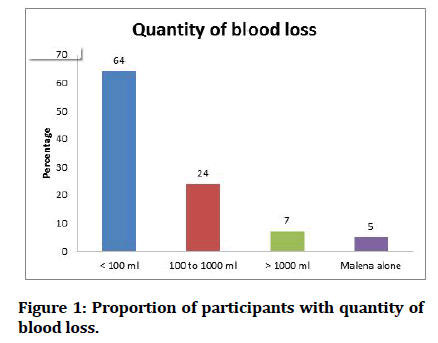Research - (2021) Volume 9, Issue 11
Quantity of Blood Observed in UGI Endoscopy Patients
Sunil Thomas George*, N Anuradha, S Suresh Kanna and Srinivasarao Gopisetty
*Correspondence: Sunil Thomas George, Department of General Medicine, Sree Balaji Medical College and Hospital, Chennai, Tamil Nadu, India, Email:
Abstract
Upper gastrointestinal bleeding is gastrointestinal bleeding in the upper gastrointestinal tract, commonly defined as bleeding arising from the oesophagus, stomach, or duodenum. Blood may be observed in vomit or in altered form as black stool. Depending on the amount of the blood loss, symptoms may include shock. Upper gastrointestinal bleeding can be caused by peptic ulcers, gastric erosions, oesophageal varices, and rarer causes such as gastric cancer. The initial assessment includes measurement of the blood pressure and heart rate, as well as blood tests to determine the haemoglobin.
Keywords
Upper gastrointestinal bleeding, Oesophagus, Stomach, Duodenum
Introduction
Upper Gastrointestinal bleeding, which most regularly arises from mucosal erosive diseases, account for up to 20,000 deaths yearly. The general prevalence of acute upper gastrointestinal haemorrhage has been assessed to be 50-100 in line with 1,00,000 people according to year, with an annual hospitalization rate of approximately a 100 in keeping with 1, 00,000 health facility admission [1-2].
Material and Methods
This study was done at Sree Balaji medical college and hospital as a prospective study for a period of 2 years. It included patients who had acute symptoms of upper gastrointestinal bleed and excluded the patients who are a known case of bleeding disorders. Number of patients affected, was studied in relation to age group, estimated amount of total blood loss, incidence of endoscopic findings in UGI bleeding.
Results
In this study the amount of blood loss was less than 100 ml in 64% of the participants while it was 100 to 1000 ml in 24% of the participants.
The amount of blood loss was more than 1000ml in 7% of the participants. Malena alone was noted in 5% of the study participants.
Among gastric ulcer patients 17 had minor hematemesis (<100ml), 6 had moderate hematemesis (100-1000 ml) while 1 patient had more than 1000 ml blood loss.
Among duodenal ulcer patients 14 and 7 had minor and moderate hematemesis respectively. Among gastric erosion cases 8 patients had minor hematemesis and 4 patients had moderate hematemesis.
In patients with oesophageal varies 4 of them had Malena. Carcinoma stomach patient presented with Malena. Among patients with gastric ulcer and duodenal ulcer 2 had major hematemesis (Table 1 and Figure 1).
| Quantity of blood loss | Percentage |
|---|---|
| < 100 ml | 64 |
| 100 to 1000 ml | 24 |
| > 1000 ml | 7 |
| Malena alone | 5 |
| Total | 100 |
Table 1: Proportion of participants with quantity of blood loss.
Figure 1: Proportion of participants with quantity of blood loss.
Discussion
Upper gastrointestinal bleeding can be caused by peptic ulcers, gastric erosions, oesophageal varices, and rarer causes such as gastric cancer. The initial assessment includes measurement of the blood pressure and heart rate, as well as blood tests to determine the haemoglobin. Significant upper gastrointestinal bleeding is considered a medical emergency. Endoscopic stigmas of active or recent bleeding include Active arterial gushing, Oozing of blood, visible vessel, fresh blood, blood clot. Factors effecting the quantity og blood loss include-Age, previous gastrointestinal bleeding, Prior gastrointestinal disease, Previous gastrointestinal surgery, underlying medical disorder (specifically liver disease),Use of non-steroidal anti–inflammatory drugs and aspirin, use of anticoagulation and/or anti–platelet therapy, Abdominal discomfort, Alteration in bowel habits, weight loss, Anorexia, History of oropharyngeal disease. These findings help in the prediction of the treatment and easy assessment of the patient status [3-4].
Conclusion
The study on endoscopic findings in upper gastrointestinal bleed concludes that minor UGI bleed was the commonest presentation. Majority of lesions presented with minor UGI bleed 24% lesions presented as moderate UGI bleed. Only 7% presented as major UGI bleed.
References
- Schein M, Gecelter G. APACHE II score in massive upper gastrointestinal haemorrhage from peptic ulcer: Prognotic value and potential clinical applications. J Br Surg 1989; 76:733-736.
- Zimmerman J, Siguencia J, Tsvnag E, et al. Predictors of mortality in hospitalized patients with secondary upper gastrointestinal hemorrhage. Scand J Gastronterol 1995; 30:327-331.
- Rockall TA, Logan RFA, Devlin HB, et al. Risk assessment after acute upper gastrointestinal hemorrhage. Gut 1996; 38:316-321.
- Jensen DM, Machicado GA, Kovacs TOG, et al. Controlled, randomized study of heater probe and BICAP for hemostasis of severe ulcer bleeding. Gastroenterol 1988; 94:A208.
Author Info
Sunil Thomas George*, N Anuradha, S Suresh Kanna and Srinivasarao Gopisetty
Department of General Medicine, Sree Balaji Medical College and Hospital, Chennai, Tamil Nadu, IndiaCitation: Sunil Thomas George, N Anuradha, S Suresh Kanna, Srinivasarao Gopisetty, Quantity of Blood Observed in UGI Endoscopy Patients, J Res Med Dent Sci, 2021, 9(11): 112-113
Received: 06-Oct-2021 Accepted: 01-Nov-2021

